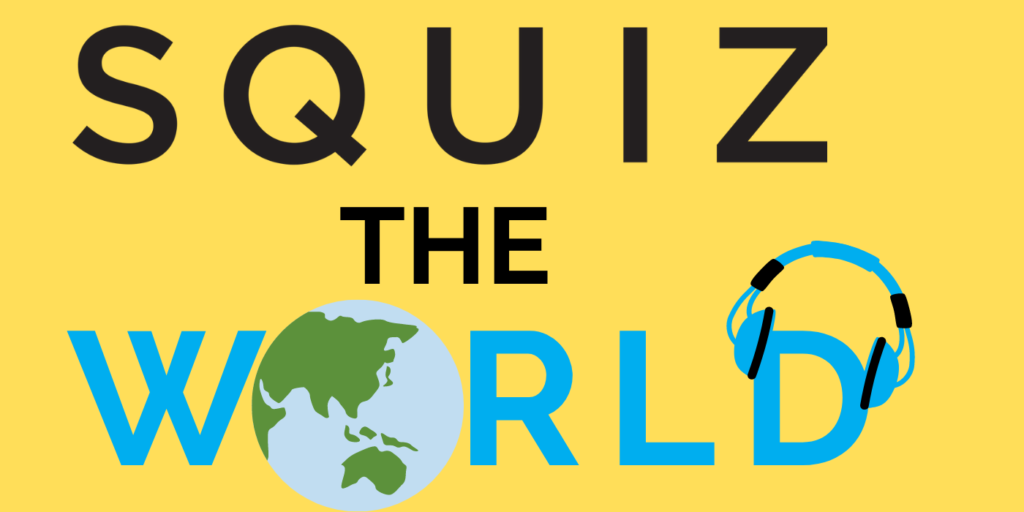
Squiz the World goes to… Japan
LINKS:
Shibuya crossing: https://www.youtube.com/watch?v=jH29fAOE1kw
Kyoshoku, or school lunch: https://www.youtube.com/watch?v=hL5mKE4e4uU
Sumo Wrestling 101: https://www.youtube.com/watch?v=Cj_QyxPZE8M
Chanko Nabe: https://www.japanesecooking101.com/chanko-nabe-recipe/
EPISODE TRANSCRIPT
Each week, we give the world globe a spin, and see where we land. Then we take the kids of Australia on an audio excursion to visit that country and its people.
I’m Amanda Bower, and today on Squiz the World we’re visiting… well, actually, let’s see if you can guess. It’s the home of Hello Kitty… sushi… sumo wrestling… and unbelievable school lunches. That’s right! We’re going to Japan.
Strap yourselves into the Squiz Kids Super Fast Supersonic Jetliner as we head north to take a squiz at the 6,852 east Asian islands that are … Japan.
Just the Facts
If you zoom in on a world map, you’ll see that Japan has a lot of neighbours! South Korea is just 50km away from Japan’s Tsushima Island. Up in the north, Russia is just 40km away from Hokkaido island. Taiwan and China are also close by.
About 66% of Japan is covered in forest, and only 421 of its 6,852 islands have people living on them. The biggest and most populated island in Japan is Honshu – that’s where the capital, Tokyo is. Many of you probably have a picture in your mind of Tokyo – lots of people, buildings, neon lights… Tokyo has 6,158 people per square kilometre – Sydney, on the other hand, has 442. I’ve put a video in your episode notes of the world’s busiest pedestrian crossing in Shibuya, Tokyo, where about 2,500 people cross everytime the little man turns green. See if it’s what you were imagining!
Tokyo is also where Japan’s 126th emperor, Emperor Naruhito, lives. An emperor is similar to a king. Japan’s emperor has had different powers through history, but nowadays, it’s just a ceremonial role, meaning that the emperor might open buildings, or attend important events, but he doesn’t have any influence over the government of Japan. In fact, Japan’s constitution bans him from making any political statements!
So yes, Japan’s 126 million people live in a democracy. They also live on what’s known as the Ring of Fire – we talked about that in our Shortcut to Earthquakes and Volcanoes.. I’ll put a link to that in your episode notes. What it means, though, is that there are about 1,500 earthquakes in Japan each year! Most of them are mild, but every now and then there’s a big one…
Whenever you travel, it’s important to learn a few words in that country’s language. It’s a great way to show respect. So, let’s….
Learn the Lingo
The official language here is Japanese, although if you’re a native speaker, you call it nihongo, and you call the country Nihon. It means “where the sun rises”, and that’s why you might hear people call Japan the “Land of the Rising Sun”. It also explains Japan’s flag, which is a red circle in the middle of a white background—Japanese people call it “flag of the sun”.
So, let’s learn some Nihongo. We are SO lucky to have a native speaking Squiz Kid, Anna, here to help us. Take it away, Anna!
(audio recording)
Arigato, Anna! If you get a chance, check out Anna’s amazing hair on our social media feed… I wonder if she’s ever had it cut??
Now that we can communicate a little bit, it’s….
Time for School
The school year in Japan starts in April, and finishes in March. You start year one in the April after you turn six, and in primary school, you learn Japanese, maths, science, social studies, music, and PE. That’s all pretty familiar to us here in Australia. But kids also learn simple cooking and sewing, calligraphy, and haiku writing.
A haiku is a very short poem – just three lines – that follows a strict rhythm. There are five syllables in the first line; seven in the second; and five in the third. Here’s the world’s silliest haiku, with a little audio magic to show you the syllables:
Haikus are easy, / but sometimes they don’t make sense / refrigerator
I have no doubt that every Japanese school kid learns to write much better haikus!
Now, without a doubt, the thing that I love most about school in Japan is lunchtime, called “kyoshoku”. Principals say it’s just as important as any other time at school, and that’s because kids aren’t just eating: they’re serving the lunches themselves, learning about the ingredients, and practicing good table manners.
Every school has its own nutritionist – a person whose job it is to help people eat a healthy diet. They get locally grown ingredients as much as possible, and plan out the meals for the school kitchen staff to cook. And what’s on the menu? Soups full of seasonal vegetables, seasoned rice, stews, grilled fish, noodles… and it must be delicious, because there are actually kyoshoku restaurants for grownups who miss their school lunches!
I’ve put a really excellent video in your episode notes where you can see kyoshoku in action at one school… it’s had 35 million views! Kids bring their own placemats, chopsticks, toothbrushes, and cups each day, serve each other food, clean up after… and then, once lunch is done, students brush their teeth, then spend 20 minutes every day cleaning their school. Pretty different from how I remember lunchtime at my school in Perth.
Speaking of food, you’ll be extremely impressed by how much one particular group of Japanese people consume. Yep, I’m talking about sumo wrestlers. It’s definitely…
Sport Time
Sumo wrestling is more than 1,000 years old, and is the national sport of Japan. It started out as a religious dance, with one person wrestling against a spirit. Nowadays, of course, it’s a professional sport in which two wrestlers push, shove, and grab each other, trying to be the first to push the other one down to the ground, or out of a circular ring. There are still a lot of aspects to sumo that are religious, though… I’ve put a great video in your episode notes to learn more.
Being big and heavy is obviously an advantage in a sport where you’re trying to push someone over, and the average weight of a sumo wrestler is 166kg. The average Japanese man weighs 62kg, so that gives you a sense of how big the wrestlers are!
It takes work to get that big and strong. Most sumo wrestlers live together in what’s called a stable – makes them sound like farm animals, doesn’t it? They wake up, do NOT eat breakfast, and get stuck into a five-hour training session. Apparently, if they had anything in their stomachs before such an intense session of pushing, shoving, hitting the dirt and getting back up again… it wouldn’t stay there.
So lunch is a BIG deal. Sumos eat a lot of fatty meat, as well as fish, rice and noodles, and of course veggies. They eat more than double what the average person does in one day… and because professional sumos wrestle every second month, all year long, they have to seriously train, and eat, all year round.
If we all promise to run around a lot today, do you think we could eat like sumos tonight? Yes? I think it might be…
Dinner Time
The dish most associated with sumos is called chanko-nabe. It’s made in one pot, by cooking meat and vegetables in a broth called dashi. Dashi is a really important ingredient in Japanese cooking – it’s made out of seaweed and dried fish, and if you’ve ever had miso soup, you’ve had dashi.
Chanko-nabe is actually pretty healthy, especially if you put lean – which means not too fatty – meat in it. One of the reasons it’s associated with wrestlers is that it’s easy to make a massive pot of it, which is what’s needed in the sumo stables to keep all those big fellas happy. And once they retire, sumos still love their chanko, as it’s known for short — lots of former wrestlers open up chanko-nabe restaurants!
I’ve included a typical recipe in your episode notes… you can use any kind of vegetables, but chicken meatballs are a really common ingredient, along with other proteins like tofu, pork, and prawns. Do it your way!
The S’Quiz
This is the part of the podcast where you get to test how well you’ve been listening.
Question 1. Name one of the two countries that are within 50km of Japan.
Question 2. What do Japanese school kids do after lunch?
Question 3. What’s the name of the short poems that Japan is famous for?
